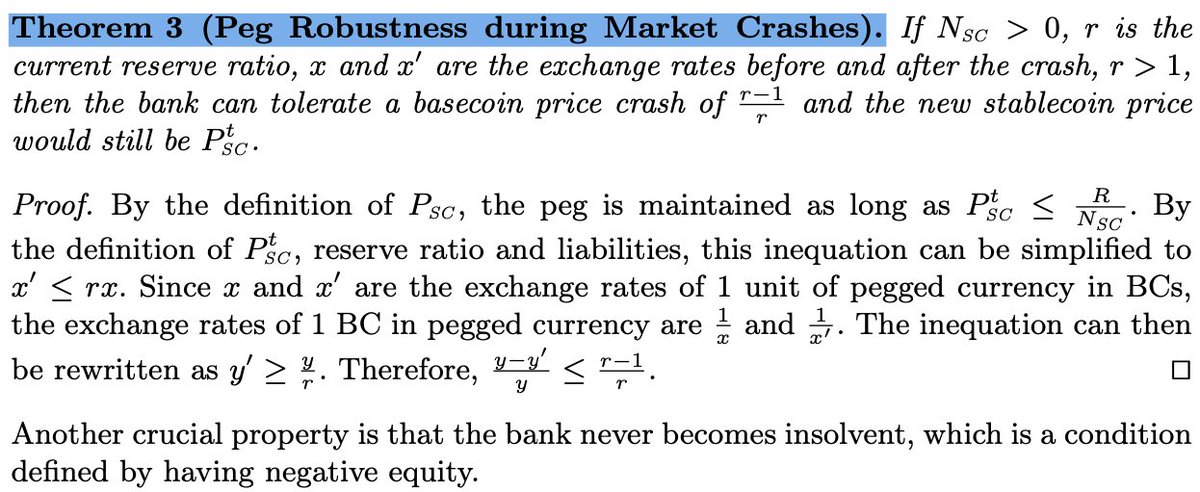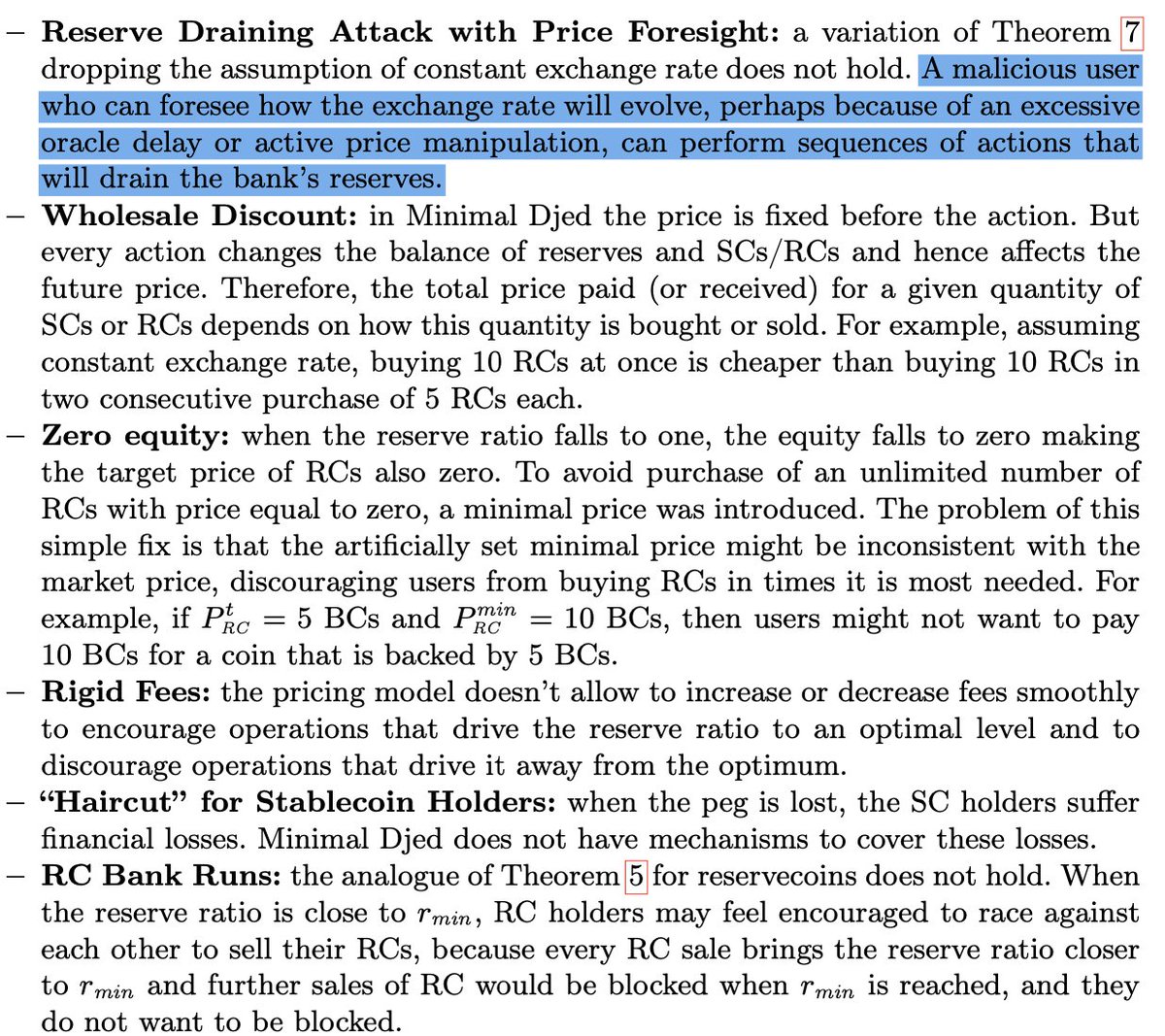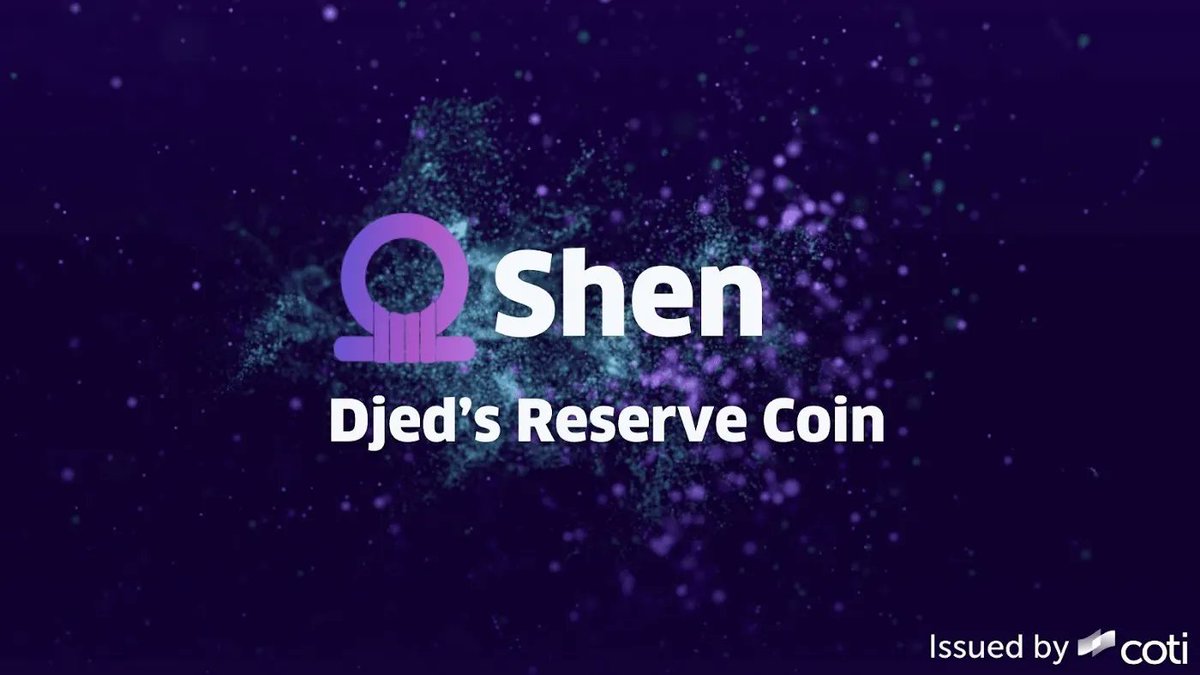
Djed was the Quintessence of ''stability'' in ancient Egypt
The symbolic backbone of the god Osiris, the god of Afterlife & Ressurection
And Stability is what Djed is bringing to the #Cardano ecosystem
Here’s a deepdive on the tech behind Djed, stable coin on #Cardano🧵👇
The symbolic backbone of the god Osiris, the god of Afterlife & Ressurection
And Stability is what Djed is bringing to the #Cardano ecosystem
Here’s a deepdive on the tech behind Djed, stable coin on #Cardano🧵👇

So what is a stable coin?
A stable coin is a price-stable digital asset
that behaves like a fiat currency
but maintains the mobility and utility of a cryptocurrency
It offers a way to bridge the gap between fiat currencies like the U.S dollar and cryptocurrencies
A stable coin is a price-stable digital asset
that behaves like a fiat currency
but maintains the mobility and utility of a cryptocurrency
It offers a way to bridge the gap between fiat currencies like the U.S dollar and cryptocurrencies

Stable coins are important for crypto markets
Because price stability is built into the assets themselves
It opens up many opportunities for DeFi and value transfer without the risk of price fluctuations
They achieve this price stability is through the underlying collateral
Because price stability is built into the assets themselves
It opens up many opportunities for DeFi and value transfer without the risk of price fluctuations
They achieve this price stability is through the underlying collateral
Based on the underlying collateral structures
They are broadly divided into 2 classes
1. Centralized asset-backed stable coins (based on the U.S. dollar)
eg: USDT, USDC
2. Decentralized algorithmic stable coins: eg DAI, SigmaUSD, etc
They are broadly divided into 2 classes
1. Centralized asset-backed stable coins (based on the U.S. dollar)
eg: USDT, USDC
2. Decentralized algorithmic stable coins: eg DAI, SigmaUSD, etc

Centralized asset-backed stablecoins came under criticism and scrutiny by authorities for the lack of transparency
USDT is a well-known example
Due to the centralization and lack of transparency
these stablecoins cant be seen as a reliable solution
decrypt.co/88250/tether-a…
USDT is a well-known example
Due to the centralization and lack of transparency
these stablecoins cant be seen as a reliable solution
decrypt.co/88250/tether-a…
On the other hand
Building a reliable algorithmic stable coin is an immense challenge
Yesterday we saw UST in free fall
The algorithmic stable coin, which had the biggest market cap was in free fall and lost its peg to the dollar
Building a reliable algorithmic stable coin is an immense challenge
Yesterday we saw UST in free fall
The algorithmic stable coin, which had the biggest market cap was in free fall and lost its peg to the dollar

This is where we realize
that methodic approach, based on research & rigorous testing is the only way to build reliable systems
That aspire to serve Billions of people
& #Cardano is pioneering this technique in the world of crypto
Now it's building a stable coin👇
that methodic approach, based on research & rigorous testing is the only way to build reliable systems
That aspire to serve Billions of people
& #Cardano is pioneering this technique in the world of crypto
Now it's building a stable coin👇
Djed is the 1st stablecoin protocol for which
Stability claims are precisely & mathematically stated, proven & formally verified
Djed's governing algorithm behaves like an autonomous Bank
that buys and sells stablecoins for a price in a range that is pegged to a target price
Stability claims are precisely & mathematically stated, proven & formally verified
Djed's governing algorithm behaves like an autonomous Bank
that buys and sells stablecoins for a price in a range that is pegged to a target price

Let's dig deeper into the ''stability properties'' of Djed
The stability properties of Djed are based on ''provable Theorems''
which are mathematically tested & verified using formal techniques
Let's try to understand the essence of these complex mathematical theorems👇
The stability properties of Djed are based on ''provable Theorems''
which are mathematically tested & verified using formal techniques
Let's try to understand the essence of these complex mathematical theorems👇
The stability properties of Djed are based on 8 ''provable Theorems''
• Peg upper and lower bound maintenance
• Peg robustness during market crashes
• No insolvency
• No bank runs
• Monotonically increasing equity per reserve coin
• No reserve draining
• Bounded dilution
• Peg upper and lower bound maintenance
• Peg robustness during market crashes
• No insolvency
• No bank runs
• Monotonically increasing equity per reserve coin
• No reserve draining
• Bounded dilution
Theorem 1 & 2: Peg upper & lower bound maintenance
This theorem states that
the price will not go above or beyond the set price
eg: the price of Djed will never go above 1.01 dollars and never go below 99.9 cents 👇
This theorem states that
the price will not go above or beyond the set price
eg: the price of Djed will never go above 1.01 dollars and never go below 99.9 cents 👇

Theorem 3: Peg robustness during market crashes
It states that
up to a set limit, depending on the reserve ratio, the peg is maintained
even when Price of the base coin crashes
eg: if the reserve ratio is 1:3, Djed can withstand a market crash of 66%
without losing the peg👇
It states that
up to a set limit, depending on the reserve ratio, the peg is maintained
even when Price of the base coin crashes
eg: if the reserve ratio is 1:3, Djed can withstand a market crash of 66%
without losing the peg👇

Theorem 4: No insolvency
This theorem states that
the equity of the smart contract governing Djed can never go bankrupt or negative
meaning
if you hold the stable coin, you will be always able to get your money back
given the peg is still maintained 👇
This theorem states that
the equity of the smart contract governing Djed can never go bankrupt or negative
meaning
if you hold the stable coin, you will be always able to get your money back
given the peg is still maintained 👇

Theorem 5: No bank runs
this basically means
in the case of a market crash
there is no incentive for users to race to redeem their stablecoins
The smart contract treats all users fairly and equally and paid accordingly 👇
this basically means
in the case of a market crash
there is no incentive for users to race to redeem their stablecoins
The smart contract treats all users fairly and equally and paid accordingly 👇

Theorem 6: Monotonically increasing equity per reserve coin
this basically means
provided that the exchange rate remains constant
the equity or the value returned to the holders of the reserve coin always increases
and reserve coin holders are guaranteed to profit from this👇
this basically means
provided that the exchange rate remains constant
the equity or the value returned to the holders of the reserve coin always increases
and reserve coin holders are guaranteed to profit from this👇

Theorem 7: No reserve draining
this theorem states that
provided that the exchange rate remains constant
it is impossible for a malicious user to execute a sequence of actions that would steal reserves from the bank / smart contract 👇
this theorem states that
provided that the exchange rate remains constant
it is impossible for a malicious user to execute a sequence of actions that would steal reserves from the bank / smart contract 👇

Theorem 8: Bounded dilution
this basically means that
there is a ''limit'' to how many reserve coin holders and their profit can be diluted
due to the issuance of more reserve coins
and this incentives users to hold reserve coins 👇
this basically means that
there is a ''limit'' to how many reserve coin holders and their profit can be diluted
due to the issuance of more reserve coins
and this incentives users to hold reserve coins 👇

The Theorems were checked for their mathematical correctness with automated tools
Researchers used 2 formal verifications methods
• Model checking: a fully automated technique
&
• Interactive theorem prover- Isabell
where you have to interact with it to prove the correctness
Researchers used 2 formal verifications methods
• Model checking: a fully automated technique
&
• Interactive theorem prover- Isabell
where you have to interact with it to prove the correctness
The Djed research paper envisions two versions of Djed
• minimal Djed: simple uncomplicated design
&
• extended Djed
minimal Djed is currently implemented on #Ergo as sigmaUSD
This version could be vulnerable to attacks like the Reserve draining attack
• minimal Djed: simple uncomplicated design
&
• extended Djed
minimal Djed is currently implemented on #Ergo as sigmaUSD
This version could be vulnerable to attacks like the Reserve draining attack

The sigmaUSD was subject to a reserve drain attack
by an anonymous user who owned a large amount of ERG
The attack was ultimately unsuccessful & the attacker is estimated to have lost $ 100,000
Extended Djed envisions to overcome these shortcomings with dynamic fees mechanism
by an anonymous user who owned a large amount of ERG
The attack was ultimately unsuccessful & the attacker is estimated to have lost $ 100,000
Extended Djed envisions to overcome these shortcomings with dynamic fees mechanism
Now that we have an idea about the formally verified ''stability properties'' of Djed
let's look at how Djed's advanced algorithm works
Djed has a Base coin, which is $Ada
and a reserve coin, which is $Shen
let's look at how Djed's advanced algorithm works
Djed has a Base coin, which is $Ada
and a reserve coin, which is $Shen

The cryptocurrency that will be backing Djed is $Ada
In order to mint the Djed
the user will need to interact with the smart contract by sending Ada to its address
after that contract will send Djed back to the user
In order to mint the Djed
the user will need to interact with the smart contract by sending Ada to its address
after that contract will send Djed back to the user
So let's assume Ada is worth $2 and Djed is worth $1
so in order to mint one Djed
the user needs to send 0.5 Ada to the smart contract
this process can be repeated
and users can send more and more $Ada to the contract and get more Djed
so in order to mint one Djed
the user needs to send 0.5 Ada to the smart contract
this process can be repeated
and users can send more and more $Ada to the contract and get more Djed
if the user wants to sell one Djed
user should send it back to the contract
which will then burn the Djed and sends back the amount of Ada that is equivalent to $1
As the price of $Ada can fluctuate
there may not be enough $Ada in the contract to give back to the Djed holders
user should send it back to the contract
which will then burn the Djed and sends back the amount of Ada that is equivalent to $1
As the price of $Ada can fluctuate
there may not be enough $Ada in the contract to give back to the Djed holders
Here is where $Shen comes into the picture
It is the reserve coin in charge of providing extra reserves for the pool
it's an ancient Egyptian symbol representing infinity & durability
unlike the Djed stablecoin
$Shen is not pegged to a specific asset & its price can fluctuate
It is the reserve coin in charge of providing extra reserves for the pool
it's an ancient Egyptian symbol representing infinity & durability
unlike the Djed stablecoin
$Shen is not pegged to a specific asset & its price can fluctuate

So what is the incentive for users to mint & hold $Shen?
There are fees associated with minting and burning $Djed & $Shen
which will be collected and sent to an $Ada pool
•$Shen holders will get a share of these fees
•&positive price appreciation from the growing $Ada pool
There are fees associated with minting and burning $Djed & $Shen
which will be collected and sent to an $Ada pool
•$Shen holders will get a share of these fees
•&positive price appreciation from the growing $Ada pool
according to @shahafbg , CEO of COTI
Djed’s collateral ratio is in the range of 400%-800%
Djed can be over collateralized (up to 8x)
this considerably decreases the risk of $Djed being unpegged
This means that for every 1 $Djed minted, there are 4-8 $Shen in the reserve pool
Djed’s collateral ratio is in the range of 400%-800%
Djed can be over collateralized (up to 8x)
this considerably decreases the risk of $Djed being unpegged
This means that for every 1 $Djed minted, there are 4-8 $Shen in the reserve pool
And If the ratio falls below 400%
users will not be able to mint $Djed
and $Shen holders won’t be able to burn their $Shen
So in the event of a market crash, there is a security for the peg of $Djed
that ensures its stability of $Djed
users will not be able to mint $Djed
and $Shen holders won’t be able to burn their $Shen
So in the event of a market crash, there is a security for the peg of $Djed
that ensures its stability of $Djed
$Djed is awaiting its first implementation on @COTInetwork
After months of development months of development
the public Testnet version of Djed was released last week
medium.com/cotinetwork/dj…
After months of development months of development
the public Testnet version of Djed was released last week
medium.com/cotinetwork/dj…
TL;DR -
• Djed is the first formally verified algorithmic stablecoin protocol
• Its stability claims have been precisely and mathematically stated, proven, and formally verified
• Djed is currently on the testnet version @COTInetwork & awaiting mainnet implementation
• Djed is the first formally verified algorithmic stablecoin protocol
• Its stability claims have been precisely and mathematically stated, proven, and formally verified
• Djed is currently on the testnet version @COTInetwork & awaiting mainnet implementation
If you found this thread valuable:
1. Toss me a follow for more threads on technical deep dives and Defi→ @Soorajksaju2
2. Here’s another thread on the L2 solution ''Orbis project'' bringing zk-Rollup on #Cardano that you might enjoy:
1. Toss me a follow for more threads on technical deep dives and Defi→ @Soorajksaju2
2. Here’s another thread on the L2 solution ''Orbis project'' bringing zk-Rollup on #Cardano that you might enjoy:
https://twitter.com/Soorajksaju2/status/1518208661084160008?s=20&t=sYZLs5mZr6x7qgAlXS209Q
• • •
Missing some Tweet in this thread? You can try to
force a refresh











